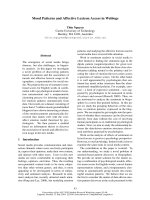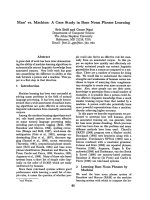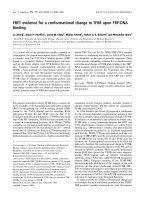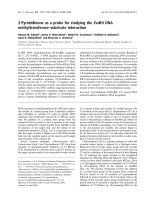báo cáo khoa học: "Segregational patterns of a chromosome insertion in the progeny of twin chimeric bulls" potx
Bạn đang xem bản rút gọn của tài liệu. Xem và tải ngay bản đầy đủ của tài liệu tại đây (416.3 KB, 5 trang )
Note
Segregational
patterns
of
a
chromosome
insertion
in
the
progeny
of
twin
chimeric
bulls
J.C.F.
MORAES
Margarete
S.
MATTEVI
*
lnstituto
Jose
Ghisolfi,
Faculdades
Unidas
de
Bag!,
96400,
Bage,
RS,
Brazil
*
Departamento
de
Genetica,
Universidade
Federal
do
Rio
Grande
do
Sul,
90001,
Porto
Alegre,
RS,
Brazil
Summary
Chromosome
studies
in
99
offspring
of twin
bulls,
know
to
be
leukocyte
chimeras
for
an
insertion
in
chromosome
16,
revealed
that
only
one
sired
heterozygotes
carrying
the
abnormal
chromosome.
This
indicated
that
the
chimerism
observed
in
the
leukocytes
did
not
extend
to
the
germ
cells.
Key
wortiv :
Cliiiiierism,
leukocyles,
germ
cells,
ins
16.
Résumé
Modalités de
ségrégation
d’une
insertion
chromosomique
dans
la
descendance
de
taureaux
jumeaux
chimériques
L’étude
chromosomique
de
99
produits
de
taureaux
jumeaux,
identifiés
comme
des
chimères
leucocytaires
pour
une
insertion
dans
le
chromosome
16,
a
montré
que
seul
un
taureau
a
engendré
des
hétérozygotes
portant
le
chromosome
anormal.
Ceci
montre
que
le
chimérisme
observé
dans
les
leucocytes
ne
s’est
pas
étendu
aux
cellules
germinales.
Mots
cléy :
Chimérisme,
leucocytes,
cellules
germinales,
ins
16.
1.
Introduction
The
insertion
in
chromosome
16,
ins
16
(fig.
la),
probably
resulted
from
a
centromeric
transposition
following
3
breaks
in
the
autosome
and
was
observed
in
leukocyte
cultures
from
7
out
of
a
total
sample
of
81
Charolais
cattle.
The
carriers
included
a
pair
of
chimeric
twin
bulls
(no.
113
and
II2)
which
respectively
presented
11/
30
(37
p.
100)
and
11/15
(73
p.
100)
of
mitotic
cells
carrying
the
submetacentric
marker
chromosome,
as
against
cells
with
a
normal
karyotype
(M
ORAES
et
al.,
1980).
Because
of
the
chimeric
nature
of
the
twins
and
the
rarity
of
the
insertion
in
the
population,
it
was
concluded
that,
in
terms
of
lymphomyeloid
stem
cells,
one
twin
must
have
originally
been
heterozygous
for
the
ins
16
whereas
the
other
twin
had
a
normal
karyotype
and
the
mixing
of
cell
populations
occurred
through
vascular
anastomosis
in
utero.
Previous
studies
of
the
segregational
patterns
of
germ
cells
in
chimeric
cattle
have
largely
been
concerned
with
the
possibility
or
otherwise
of
the
survival
and
function
of
opposite
sex
germ
cells
in
the
gonads
of
bulls
and
freemartin
pairs
(see
for
example,
FORD
&
E
VANS
,
1977).
In
many,
vascular
anastomosis
is
thought
to
occur
sufficiently
early
for
primordial
germ
cells
in
the
circulation
to
pass
from
one
fetus
to
the
gonads
of
another
(JosT
&
PRT
PIN
,
1966)
but,
in
others,
as
in
the
case
of
the
rare
fertile
freemartins
(E
LDRIDGE
&
B
LAZAK
,
1977 ;
SMITH
et
al.,
1977 ;
M
IYAKE
et
al.,
1980),
it
may
occur
too
late.
The
issue
cannot
be
totally
resolved
in
the
bulls
because
of
the
conflicting
reports
regarding
the
ability
of
XX
germ
cells
to
survive
in
the
testis.
In
some
matings
from
these
bulls,
claims
have
been
made
that
they
can
survive
since
an
excess
of
female
progeny
were
born,
in
others
normal
sex-ratios
were
found
suggesting
no
enhancement
of
X
bearing
gametes
(see
for
example,
F
EJ
TR
&
Kova,cs,
1980).
The
latter
observation
could
have
resulted
from
either
that
the
XX
germ
cells
reached
the
testis
and
failed
to
survive
in
a
foreign
environment,
or
that
late
vascular
anastomosis
prevented
their
migration
in
the
first
place.
The
discovery
of
the
bull
twins
chimeric
for
an
autosomal
marker
chromosome,
ins
16,
provides
a
means
of
exploring
these
2
possibilities.
If
the
primordial
germ
cells
did
migrate
from
the
heterozygous
fetus
to
the
normal
testis
they
would
expected
to
survive
since
they
are
syngenetic
and,
more
importantly,
carry
a
Y
chromosome.
The
aim
of
this
study
was
to
investigate
this
possibility
by
chromosome
analysis
of
the
offspring
of
the
chimeric
bulls.
II.
Materials
and
methods
197
cows
were
artificially
inseminated
with
frozen
semen,
106
from
the
semen
of
bull
113
and
91
from
that
of
bull
112.
In
the
resulting
offspring
99
animals
were
karyotyped
by
the
method
of
M
OORHEAD
et
al.
(1960)
using
leukocyte
cultures
set
up
in
RPMI
1640
(Flow)
with
20
p.
100
fetal
calf
serum,
4
p.
100
phytohemaglutinin
M
(Difco),
100
LU.
of
penicillin
and
100
mg/ml
of
streptomycin.
The
metaphases
were
conventionally
stained
in
Giemsa
and
15
analysed
for
each
animal.
III.
Results
and
discussion
The
distribution
of
the
karyotype
classes
observed
in
the
offspring
of
the
2
bulls
are
shown
in
table
1.
In
bull
II3,
26
out
of
a
total
sample
of
61,
or
43
p.
100
were
heterozygous
for
ins
16
(fig.
la),
a
frequency
which
is
not
at
variance
with
the
50
p.
100
expected
(X
2
=
1.05 ;
1
D.F. ;
P
>
0.30)
if
the
bull
was
a
complete
germ
line
heterozygote
and
lacked
germ
cells
with
a
normal
karyotype.
In
contrast,
bull
II2
sired
38
offspring
all
of
which
were
of
a
normal
karyotype
(fig.
lb)
which
suggested
that
his
germ
line
did
not
carry
the
insertion.
The
difference
between
the
frequency
of
heterozygous
offspring
observed
for
the
2
bulls
is
highly
significant
(X
2
=
22.00 ;
I
D.F. ;
P
<
0.001).
Surprisingly,
bull
II3,
although
seemingly
totally
heterozygous
in
his
germ
line
showed
a
lower
frequency
(37
p.
100)
of
cells
carrying
ins
16
in
his
leucocyte
culture
than
did
his
twin
(73
p.
100)
with
a
probable
normal
germ
line.
As
only
one
sample
of
blood
was
cultured
and
other
tissues
were
not
sampled,
it
is
inappropriate
to
draw
conclusions
from
this
observation.
The
results
obtained
from
the
leukocyte
cultures
of
the
offspring
are
of
interest
for
the
following
reason.
In
contrast
to
the
situation
in
the
testes
of
bulls
born
as
cotwins
to
freemartins
in
which
any
XX
cells
are
at
a
disavantage
in
having
both
the
wrong
X
chromosome
dosage
and
being
in
a
potentially
hostile
XY
environment
(see
FORD
&
E
VANS
,
1977),
the
normal
and
heterozygous
primordial
germ
cells
in
the
2
bulls
described
here
should
be
of
an
equivalent
proliferative
capability
because
of
their
equivalent
genotypes.
Thus,
differences
in
the
frequencies
of
gametes
subsequently
produced
could
only
result
from
differences
in
the
initial
number
of
primordial
germ
cells
present
during
the
occupation
of
the
fetal
gonad.
It
has
been
argued
earlier
that
it
is
more
feasible
to
consider
that
the
twin
zygotes
were
initially
heterozygous
and
normal
and
leukocyte
chimerism
arose
later
by
vascular
anastomosis.
If
this
was
the
case,
bull
II3,
although
having
the
lower
leukocyte
frequency,
is
the
obvious
candidate
for
the
heterozygote
and
bull
II2
for
the
normal.
The
absence
of
germ
cell
chimerism
in
the
latter
could
be
explained
by
vascular
anastomosis
taking
place
after
the
migration
of
the
primordial
germ
cells
to
the
site
of
the
primitive
gonad
had
finished,
a
mechanism
which
has
been
previously
suggested
to
explain
the
occurrence
of
the
rare
case
of
fertile
freemartins
(E
LDRIDGE
&
B
LAZAK
,
1977 ;
SMITH
et
al.,
1977 ;
NII
YAKE
et
al.,
1980).
Our
results
support
the
conclusion
that
leukocyte
chimerism
through
vascular
anastomosis
does
not
necessarily
include
germ
cell
chimerism.
Received
February
12,
1986.
Accepted
September
12,
1986.
Acknowledgements
We
are
grateful
to
Dr.
A.K.
V
AZ
for
reviewing
our
manuscript,
and
we
acknowledge
the
help
provided
by
one
anonymous
referee
who
has
re-written
the
paper.
This
work
was
supported
by
the
Conselho
Nacional
de
Desenvolvimento
Cientffico
e
Tecnol6gico
(PIG)
and
by
the
Fundaqdo
de
Amparo
à
Pesquisa
do
Estado
do
Rio
Grande
do
Sul.
References
E
LDRIDGE
F.E.,
B
LAZAK
W.F.,
1977.
Chromosomal
analysis
of
fertile
female
heterosexual
twins
in
cattle.
J.
Dairy
Sci. ,
60,
458-463.
FE
itR
T.,
Kovkcs
A.,
1980.
Offspring
sex-ratio
of
XX/XY
chimaenc
bulls.
Proc.
4th
Eur.
Colloq.
Cytogenet.
Domest.
Anim.,
Uppsala,
June
10-13,
1980, 94-98.
Department
of
Animal
Breeding
and
Genetics,
Faculty
of
Veterinary
Medicine,
Swedish
University
of
Agricultural
Sciences,
Uppsala.
FORD
C.E.,
E
VANS
E.P.,
1977.
Cytogenetic
obs6rvations
on
XX/XY
chimaeras
and
a
reassessment
of
the
evidence
for
germ
cell
chimaerism
in
heterosexual
twin
cattle
and
marmosets.
J.
Reprod.
Fert.,
49,
25-33.
Jos
T
A.,
PRT
PIN
J.,
1966.
Donndes
sur
la
migration
des
cellules
germinales
primordiales
du
foetus
de
veau.
Arch.
Anat.
Microsc.
Morph.
Exp.,
55,
161-186.
M
IYAKE
Y.,
1
SHIKAWA
T.,
A
BE
T.,
K
OMATZU
M.,
K
ODAMA
Y.,
1980.
A
fertile
case
of
a
bovine
heterosexual
twin
female
with
sex-chromosomal
chimerism.
Zuchthygiene,
15,
103-106.
M
OORHEAD
P.S.,
N
OWELL
P.C.,
M
ELLMAN
W.J.,
BA
TT
IPS
D.M.,
H
UNGERFORD
D.A.,
1960.
Chromo-
some
preparations
of
leukocyte
cultures
from
human
peripheral
blood.
Exp.
Cell
Res.,
20,
613-616.
M
ORAES
J.C.F.,
MA
TTEW
M.S.,
S
ALZANO
F.M.,
P
OLI
J.L.E.H.,
E
RDTMANN
B.,
1980.
A
cytogenetic
survey
of
five
breeds
of
cattle
from
Brazil.
J.
Hered.,
71,
146-148.
SMITH
G.S.,
V
AN
CAMP
S.D.,
B
ASRUR
P.K.,
1977.
A
fertile
female
co-twin
to
a
male
calf.
Can.
Vet.
J. ,
18,
287-289.









